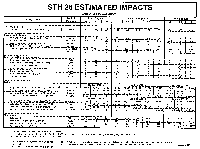| What is an Environmental Impact Statement?
An Environmental Impact Statement (EIS) is the decision document for a major highway project like the Highway 26 project. The EIS pulls together community and agency interests, and recommends a future course of action.
An EIS is required by the National and Wisconsin Environmental Policy Acts for projects with potentially significant social, economic, natural resource, and other impacts. The Federal Highway Administration (FHWA) is the lead agency for the EIS, and it will be prepared in accordance with their guidelines. The main parts of the EIS are Purpose and Need for the Proposed Action, Alternatives, and Environmental Consequences.
The first version is a Draft EIS. The Draft EIS discusses the No Action Alternative and a range of reasonable Build Alternatives along with their impacts. The Final EIS documents the recommended alternative and reasons for its selection, following a public hearing.
The Highway 26 Draft EIS is due in May 2000.
Matrix of effects
The Environmental Impact Statement (EIS) will include a comparison of impacts between viable altematives. A preliminary screening matrix will be used to narrow the various corridor alternatives to those that are most viable. The matrix showing the impacts for the South, Cental and North areas is available at today's meeting.
Click on the image for a larger, more detailed view of the STH 26 Estimated Impacts matrix.

Outline of an EIS
Below is a sample outline of an EIS.
| Sec. |
Title |
|
Index |
| ES |
Executive Summary |
| 1 |
Purpose and Need |
| 1.1 |
Introduction |
| 1.2 |
History |
| 1.3 |
Previous Studies Conducted |
| 1.4 |
Need for the Project |
| 1.5 |
Purpose of Project |
| 1.6 |
Relationship of the Proposed Project to the Statewide Plan or Urban Transportation Plan |
| 1.7 |
Legislation Regarding the Proposed Project |
| 1.8 |
Relationship of the Proposed Project to Other Modes of Transportation |
| 2 |
Alternatives |
| 2.1 |
Introduction |
| 2.2 |
Initial Identification of Alternatives |
| 2.3 |
Criteria for Screening Alternatives |
| 2.4 |
Public Input |
| 2.5 |
Alternatives Considered but Eliminated from Detailed Evaluation |
| 2.6 |
Alternatives Studied in Detail |
| 2.7 |
No Build Alternative |
| 2.8 |
Logical Termini |
| 3 |
Affected Environment, Environmental Consequences, and Measures to Minimize Harm |
| 3.1 |
Air Quality |
| 3.2 |
Noise |
| 3.3 |
Biology |
| 3.4 |
Water Resources |
| 3.5 |
Cultural Resources |
| 3.6 |
Land Use |
| 3.7 |
Visual Resources |
| 3.8 |
Recreation Resources |
| 3.9 |
Socioeconomics |
| 3.10 |
Hazardous Materials |
| 3.11 |
Construction Activities and Impacts |
| 3.12 |
Energy |
| 3.13 |
Local Short-term Uses Versus Long-term Productivity |
| 3.14 |
Irreversible and Irretrievable Commitment of Resources |
| 4 |
Unavoidable Adverse Impacts |
| 4.1 |
Introduction |
| 4.2 |
Air |
| 4.3 |
Noise |
| 4.4 |
Biological Resources |
| 4.5 |
Water Resources |
| 4.6 |
Cultural Resources |
| 4.7 |
Land Use |
| 4.8 |
Visual Resources |
| 4.9 |
Recreation |
| 4.10 |
Socioeconomics |
| 4.11 |
Hazardous Materials |
| 5 |
Cumulative Impacts |
| 5.1 |
Introduction |
| 5.2 |
Past and Present Land Uses and Facilities in the Project Area |
| 5.3 |
Reasonably Foreseeable Highway Programs in the Project Area |
| 5.4 |
Clark County's Desert Conservation Program |
| 5.5 |
Conclusions |
| 6 |
Section 4(f) Evaluation |
| 6.1 |
Purpose of Section 4(f) Evaluation |
| 6.2 |
Proposed Project |
| 6.3 |
Section 4(f) Properties |
| 6.4 |
Impacts on the Section 4(f) Properties |
| 6.5 |
Avoidance Alternatives |
| 6.6 |
Measures to Minimize Harm |
| 6.7 |
Coordination |
| 7 |
Coordination and Consultation |
| 7.1 |
Introduction |
| 7.2 |
Public Scoping |
|
| 7.3 |
Public Comment Meetings |
| 7.4 |
Public Agency Partnering Session |
| 7.5 |
Project Management Team Meetings |
| 7.6 |
Public Outreach |
| 7.7 |
EIS Public Review and Comment |
| 7.8 |
Permits |
| 8 |
List of Report Preparers |
| 9 |
References |
| 10 |
List of Agencies, Organizations, and Persons to Whom Copies of the Environmental Impact Statement are Sent |
|
Appendix A Traffic Analysis |
|
Appendix B Correspondence |
|
Acronyms and Abbreviations |
|